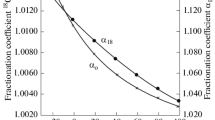Abstract
A tunable diode laser and a multipass optical cell are used to investigate the feasibility of performing radiocarbon dating by means of infrared spectroscopy. We show that the detection of14CO2 at concentrations of14C/12C≲10−12 is not limited by interferences from the background of normal CO2 molecules, provided the gas sample is cooled. Using short-time constants, the present sensitivity of the infrared technique is comparable to that of an ideal disintegration counter. The experimental results are extrapolated to long time constants to demonstrate that radiocarbon dating by infrared spectroscopy is feasible, and that carbon samples with a mass of less than 1 gm can be dated by this technique.
Similar content being viewed by others
References
B.Lehmann, M.Wahlen, R.Zumbrunn, H.Oeschger, W.Schnell. Appl. Phys.13, 153–158 (1977)
R.A.Muller: Physics Today 23–30 (Feb. 1979)
K.N.Rao (ed.):Molecular Spectroscopy: Modern Research, Vol. II (Academic Press, New York 1976) Chapt. 4
A.S.Pine, G.Guelachvili: J. Mol. Spectrosc.79, 84–89 (1980)
D.Bailly, R.Ferrenq, C.Rossetti: J. Mol. Spectrosc.70, 124–133 (1978)
A.Baldacci, L.Linden, V.M.Devi, K.N.Rao, B.Fridovich: J. Mol. Spectrosc.72, 135–142 (1978)
A.Baldacci, V.M.Devi, D-WChen, K.N.Rao, B.Fridovich: J. Mol. Spectrosc.70, 143–159 and 160–162 (1978)
R.S.Eng, K.W.Nill, M.Wahlen: Appl. Opt.16, 3072–3074 (1977)
G.Guelachvili: J. Mol. Spectrosc.79, 72–83 (1980)
T.K.McCubbin, Jr., J.Pliva, R.Pulfrey, W.Telfair, T.Todd: J. Mol. Spectrosc.49, 136–156 (1974)
D.A.Steiner, T.R.Todd, C.M.Clayton, T.K.McCubbin, Jr., S.R.Polo: J. Mol. Spectrosc.64, 438–451 (1977)
L.S.Rothman, W.S.Benedict: Appl. Opt.17, 2605–2611 (1978)
M.Wahlen, R.S.Eng, K.W.Nill: Appl. Opt.16, 2350–2352 (1977)
M.J.Aitken: Physics Rep.40, 278–351 (1978)
J.Reid, B.K.Garsíde, J.Shewchun, M.El-Sherbiny, E.A.Ballik: Appl. Opt.17, 1806–1810 (1978)
J.Reid, M.El-Sherbiny, B.K.Garside, E.A.Ballik: Appl. Opt.19, 3349–3354 (1980)
M.El-Sherbiny, E.A.Ballik, J.Shewchun, B.K.Garside, J.Reid: Appl. Opt.18, 1198–1203 (1979)
C.Amiot, G.Guelachvili: J. Mol. Spectrosc.59, 171–190 (1976)
Any further increase in gas temperature resulted in many additional lines appearing and caused an unnecessary complication of the spectrum
W.Berger, K.Siemsen, J.Reid: Rev. Sci. Instrum.48, 1031–1033 (1977)
The hot CO2 cell has a non-uniform temperature distribution [19]. The cell is warm in the middle, but cool at the ends. Nevertheless, the results shown in Fig. 7 indicate that the uniform temperature model is a good approximation
Author information
Authors and Affiliations
Additional information
This work was supported in part by the National Science and Engineering Research Council of Canada.




